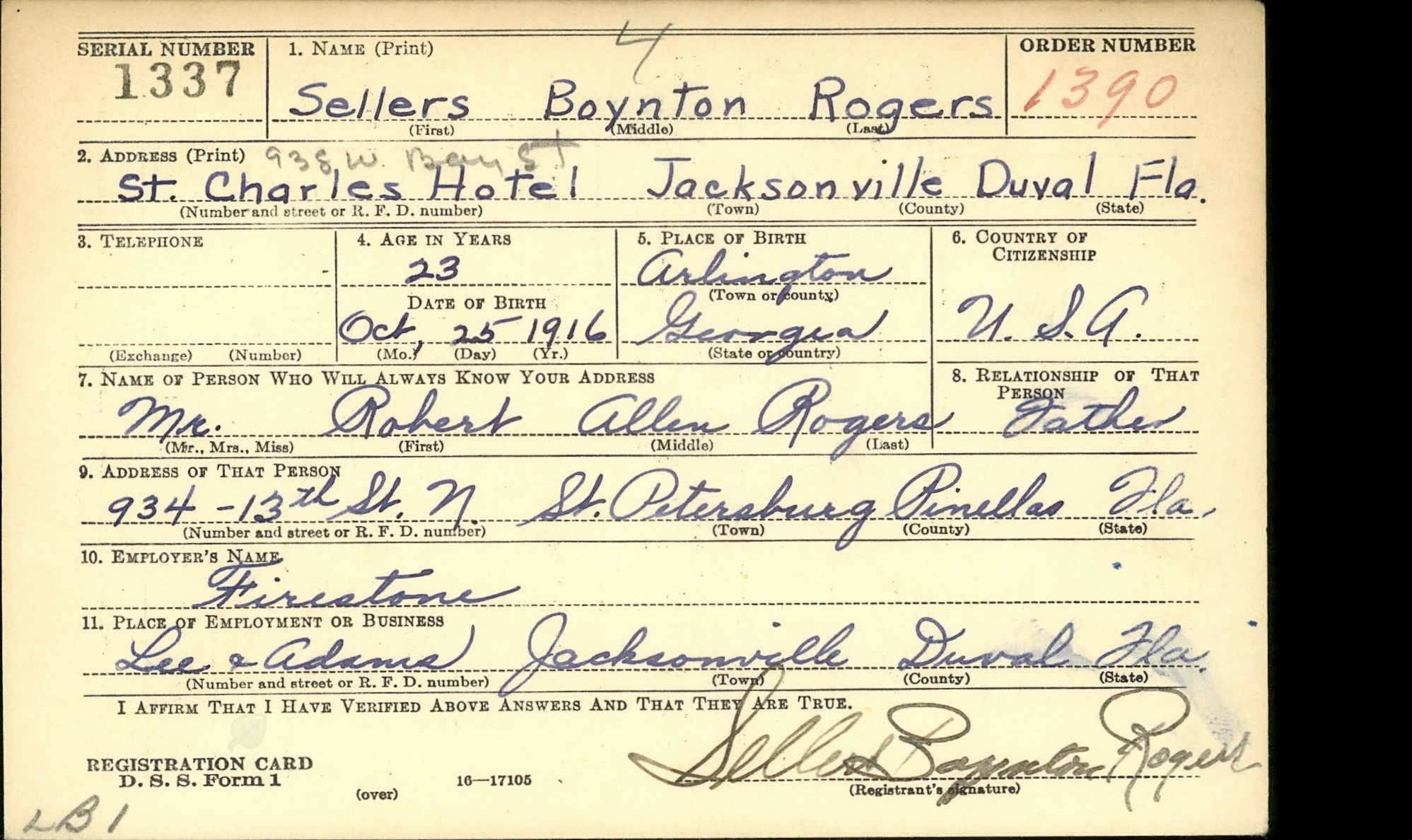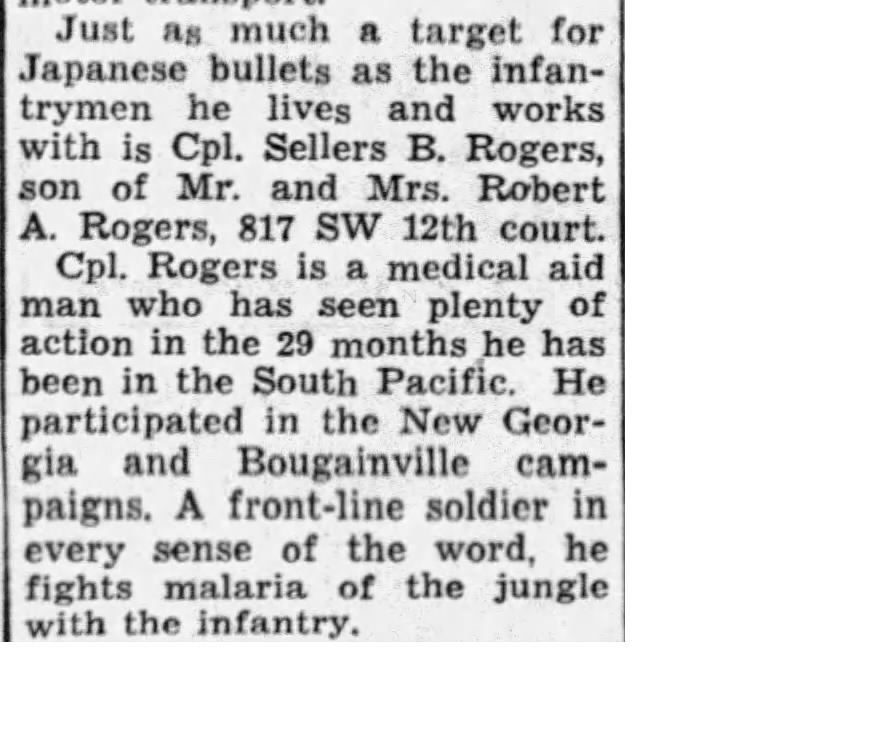Sellers Boynton Rogers (October 25, 1917–January 12, 1996)
By Kenneth Holliday
Early Life
Sellers Boynton Rogers was born on October 25, 1917 to Robert Allen Rogers and Myra Rogers in Arlington, Georgia.1 He was the third of six children. His elder siblings were brother Robert Rogers and sister Stella Rogers.2 Robert Allen and Myra later gave birth to three more children, giving Sellers two younger brothers, William and Richard, and one younger sister, Clare.3
Sellers Rogers’ father spent a good portion of his life in the paint industry as a store merchant. In 1920, he was recorded to be a manager at a paint store in Arlington, Georgia.4 By 1930, the Rogers family had moved to Jacksonville, Florida, where Sellers’ younger brother, William Harvey, was born.5 The Rogers family continued to grow into 1932 when the youngest child, Richard, was born.6 Robert Allen Rogers maintained the same occupation as a paint store manager throughout Seller’s childhood and through various locations. By 1935, the family had moved to St. Petersburg, Florida.7
By 1940, Sellers’ older siblings had moved out of the family house. Robert had stayed in the St. Petersburg area, and went on to join the Navy in 1942.8 His sister Stella moved to Houston, Texas, and began working as retail saleslady in a “men’s and women’s ready to wear” store, eventually marrying.9 With his two older siblings having moved away, Sellers was the eldest child of the Rogers family still living at home. At age twenty-one, Sellers Rogers spent about six months working as a gas station attendant before becoming unemployed again by the time the 1940 US Census was taken.10 That same year, Sellers Rogers registered for the draft on October 16, 1940.11 It seems that Sellers continued to struggle to find a steady job, and less than a year after registering for the draft, he enlisted into the United States Army on June 25, 1941 at Camp Blanding, Florida.12
Military Career: Combat Medic in the Pacific Campaigns of WWII
Sellers Rogers had a very eventful and interesting military career. His actions earned him a Silver Star; wounded during some of these actions, he was awarded the Purple Heart. He is mentioned multiple times through local newspapers and was regarded as a hometown hero. Though sometimes brief, the pieces about Sellers in newspapers describe him as a valorous and courageous soldier.
Rogers served in the Army as a Combat Medic.13 He spent the majority of his time in the Army serving in the South Pacific Campaigns of World War II. By November, 1944, a newspaper entry in The Miami News stated that Rogers had been serving in the Pacific for twenty-nine months, placing his arrival there as early as May 1942.14 Rogers participated in various campaigns in the Pacific all the way through at least June 1945, making him a seasoned veteran who was engaged in the war for more than three years.
Rogers undoubtedly experienced combat during his three years at war in the South Pacific. He participated in the campaigns of New Georgia, Bougainville, Luzon, and the liberation of Manila.15 He likely served in the 37th Infantry Division, which was a National Guard Division from Ohio, for the entirety of his service.16
Rogers and the 37th Infantry deployed to the Pacific on May 26, 1942, arriving on the Fiji Islands in June. There, they garrisoned the island for the possibility of Japanese invasion and continued training until April, 1943.17 The 37th Infantry then deployed to Guadalcanal to stage for the invasion of Munda in July. While staging in Guadalcanal, two battalions in the 37th Infantry were attached to the Marines to assist their campaign in New Georgia.18 While the rest of the 37th Infantry took Munda, Rogers and the Marines fought to secure New Georgia.19
Following the successes in New Georgia, Sellers Rogers returned to Guadalcanal to regroup with the rest of the 37th Infantry, who returned in September 1943 for a much-needed relief after heavy fighting on Munda.20 From November 1943 to January 1945, Rogers and the 37th Infantry took over defense of Bougainville.21 During this time, the Japanese launched eight major attacks against Bougainville. Though heavy fighting ensued, the 37th Infantry was able to hold defensive lines against the attacks at a costly price. While defending six square miles of friendly lines protecting an airfield, the 37th Infantry held off Japanese attacks for days. Rogers’ abilities as a combat medic would have been fully tested during these days. The terrain and large number of enemy forces meant that evacuation of those wounded was difficult. The only “safe” way to move casualties was through the use of the 37th Cavalry Reconnaissance’s armored vehicles.22 The only other alternative was to carry the wounded by hand over a difficult mountain trail.23 The evacuation missions were often attacked by the enemy with major routes regularly being mortared.24
On January 9, 1945, the 37th Infantry landed in Lingayen Gulf and headed towards Manila. Along the way, the 37th Infantry liberated Clark Field and Fort Stotsenburg after facing heavy enemy resistance.25 By the beginning of February, the unit had reached Manila but still faced heavy opposition from the Japanese occupying forces.26 It took a month for the 37th Infantry to successfully liberate Manila by March 1945. By April, the division headed for Luzon.27
Throughout all of the 37th Division’s campaigns, Sellers Rogers performed a very important role to the infantry he was attached to. He treated wounded men and gave them life-saving medical aid. While in Luzon, Rogers was recognized for his gallantry. Risking his own life, Rogers “crawled fifty yards to rescue a comrade.”28 During the rescue, he was hit by incoming mortars but kept going to save his injured comrade.29 Rogers was then hit again, this time by rifle fire, but was still able to rescue the wounded man and bring him back to their own lines.30 For his heroic actions that day, Sellers Rogers was awarded the Silver Star Medal, the third highest decoration for valor. He also received a Purple Heart Medal for wounds received during the rescue.31
Sellers Rogers stayed in the South Pacific through the end of the war. Finally, on September 12, 1945, just ten days after the formal surrender of Japan, Sellers Rogers was discharged from the Army.32
Post-Service
Sellers Rogers returned home as a battle-tested veteran who had spent three years of his young adult life in war. He was regarded as a hero in the newspapers of Miami where his parents lived. It appears that he moved to Miami immediately after discharge, to live either near or with his parents. One year later, on August 8, 1946, he married Margaret Mann in Miami.33 The newlywed couple appears to have remained in Miami for the majority of their lives, appearing in The Miami News newspaper in 1952.34
Unfortunately, additional sources that may provide more information on their lives beyond this are scarce. It appears that in 1993, Rogers moved to the Fort Lauderdale area in Broward County, Florida.35 There, Sellers Rogers spent the last years of his life. Sellers Boynton Rogers died on January 12, 1996 at age seventy-eight.36 He is memorialized at Florida National Cemetery in Bushnell, Florida, and is recognized for his Silver Star Medal and Purple Heart Medal.37 During his three years in the South Pacific, he undoubtedly saved a number of lives of the men he served with. Though he is now gone, his legacy will always be remembered.
Endnotes
1 “Social Security Death Index, 1935-2014,” database, Ancestry.com, https://www.ancestry.com (accessed June 28, 2017), entry for Sellers B. Rogers.
2 “1920 United States Federal Census,” database, Ancestry.com, https://www.ancestry.com (accessed June 27, 2017), entry for Sellers Rogers.
3 “1930 United States Federal Census,” database, Ancestry.com, https://www.ancestry.com (accessed June 28, 2017), entry for Sellers Rogers.
4 1920 United States Federal Census,” database, Ancestry.com, https://www.ancestry.com (accessed June 27, 2017), entry for Sellers Rogers.
5 “1930 United States Federal Census,” database, Ancestry.com; “Social Security Applications and Claims Index, 1936-2007,” database, Ancestry.com, https://www.ancestry.com (accessed July 2, 2017), entry for William Harvey Rogers.
6 “Social Security Death Index, 1935-2014,” database, Ancestry.com, https://www.ancestry.com (accessed July 2, 2017), entry for Richard H. Rogers.
7 “Florida, State Census, 1867-1945,” database, Ancestry.com, https://www.ancestry.com (accessed July 2, 2017), entry for Sellers Rogers.
8 “Department of Veterans Affairs BIRLS Death File, 1850-2010,” database, Ancestry.com, https://www.ancestry.com (accessed June July 1, 2017), entry for Robert Rogers.
9 “1940 United States Federal Census,” database, Ancestry.com, https://www.ancestry.com (accessed July 1, 2017), entry for Stella Haskell.
10 “1940 United States Federal Census,” database, Ancestry.com, https://www.ancestry.com (accessed June 27, 2017), entry for Sellers Rogers.
11 “WWII Draft Cards Young Men, 1940-1947,” database, Ancestry.com, https://www.ancestry.com (accessed June 27, 2017), entry for Sellers Boynton Rogers.
12 “World War II Army Enlistment Records, 1938-1946,” database, Ancestry.com, https://www.ancestry.com (accessed June 27, 2017), entry for Sellers B. Rogers.
13 “Cpl. Sellers B. Rogers.” The Miami News., November 19, 1944, page 18, database, Newspapers.com, https://www.newspapers.com (accessed July 11, 2017).
14 Ibid.
15 Ibid.
16 “U.S. Army Awards of the Silver Star, World War II,” HomeoftheHeroes, https://www.homeoftheheroes.com (accessed June 27, 2017). This notes that the awarding of the Silver Star Medal to Sellers B. Rogers comes from the 1945 General Orders No. 61 of the 37th Infantry Division.
17 Department of the Army, The Army Almanac: A Book of Facts Concerning the Army of the United States (Washington D.C.: U.S. Government Printing Office, 1950), 539.
18 Ibid.
19 Ibid.
20 Ibid.
21 Ibid.
22 “Battle of Bougainville: 37th Infantry Division’s Battle for Hill 700,” HistoryNet, https://www.historynet.com (accessed July 12, 2017).
23 Ibid.
24 Ibid.
25 Department of the Army, The Army Almanac, 539.
26 Ibid.
27 ibid
28 “Cpl. Sellers B. Rogers.” The Miami News., May 6, 1945, Page 8, database, Newspapers.com, https://www.newspapers.com (accessed July 11, 2017).
29 Ibid.
30 Ibid.
31 Ibid.
32 “Department of Veterans Affairs BIRLS Death File, 1850-2010,” database, Ancestry.com, https://www.ancestry.com (accessed July 12, 2017), entry Sellers Rogers.
33 “Florida, County Marriages, 1823-1982,” database, Ancestry.com, https://www.ancestry.com (accessed June 27, 2017), entry Sellers B. Rogers.
34 “Music Hath Charms.” The Miami News., October 15, 1952, Page 16, database, Newspapers.com, https://www.newspapers.com (accessed July 12, 2017).
35 “U.S. Public Records Index, 1950-1993,” database, Ancestry.com, https://www.ancestry.com (accessed June 27, 2017), entry Sellers B. Rogers.
36 “Social Security Death Index, 1935-2014,” database, Ancestry.com, https://www.ancestry.com (accessed June 28, 2017), entry for Sellers B. Rogers.
37National Cemetery Administration, "Sellers B. Rogers," US Department of Veterans Affairs, accessed September 18, 2018, https://gravelocator.cem.va.gov/NGLMap?ID=5805145
© 2017, University of Central Florida




